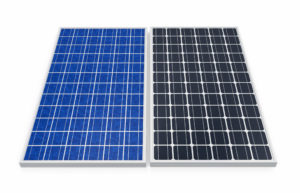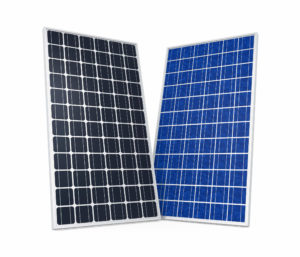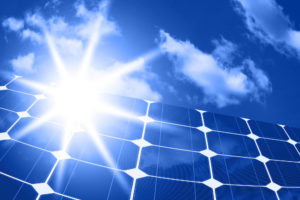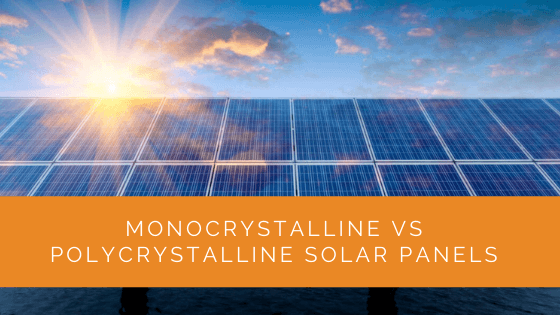Solar energy technology has undergone a major revolution since its inception. Today, one of the first choices you’re faced with while picking out solar panels is the kind of cells you would like – monocrystalline vs. polycrystalline.
Both of these panel categories are conventional options that have been around for decades. While they’re both capable of harnessing the sun’s energy, they have some noteworthy differences.
Let us understand in detail how the two solar panels work and what makes them so different so that you can make an informed decision when investing in a solar panel system.
Contents
- 1 Key Takeaways
- 2 How Does Solar PV Work?
- 3 What Are Monocrystalline Solar Panels?
- 4 What Are Polycrystalline Solar Panels?
- 5 Comparing Monocrystalline And Polycrystalline Solar Panels
- 6 Other Solar Cell Technologies
- 7 Case Study: Transitioning to Monocrystalline Solar Panels for a Residential Property
- 8 Expert Insights From Our Solar Panel Installers About Monocrystalline Vs. Polycrystalline Solar Panels
- 9 Experience Solar Excellence with Us!
- 10 Wrap Up
Key Takeaways
- Monocrystalline solar panels are known for their higher efficiency, longer lifespan, and space efficiency, but they tend to be more expensive.
- Polycrystalline solar panels are more affordable but have lower efficiency, making them suitable for areas with ample space and moderate climates.
- Factors like temperature tolerance, natural forces, and recyclability also play a role in choosing the right solar panel for your specific needs.
How Does Solar PV Work?
Substances and appliances with photovoltaic (PV) technology transform sunlight into electrical energy. A PV device, called a cell, is typically small and produces very little power, just one or two watts.
If you’re wondering how small the cells are, their thickness is less than that of four strands of human hair. They are made up of various semiconductor materials.
Since collar panels are installed outdoors, they need protection against the forces of nature. Therefore, they are packed between protective glass or plastic materials.
PV cells are connected to one another via chains in order to form huge panels or modules to boost the power output. These panels can either be used in isolation or be connected for creating arrays.
One or many arrays are thereafter linked to the electrical grid. Such a structure ensures that PV systems are capable of catering to all kinds of electrical needs.
Besides arrays and modules, a photovoltaic system also includes mounting equipment that points the panels towards the sun. Moreover, there are also some other parts that take the direct current (DC) and convert it to the alternating current (AC), which is used to power appliances.

What Are Monocrystalline Solar Panels?
Monocrystalline solar panels are generally positioned as relatively premium solar energy products. They boast of splendid aesthetics and higher efficiency.
For making monocrystalline solar cells, a seed of silicon is dipped in a container of molten silicon. The seed is then slowly rotated and raised, pulling some molten silicon with it. As the seed is pulled out, it solidifies into a single crystal cylinder, referred to as an ingot.
These ingots are slashed into bars and then cut to create square-shaped silicon wafers. The corners are generally shaved down to a hexagonal shape.
Finally, the silicon wafers are arranged into panels. Typically, there are 60-cell or 72-cell panels.
Since the material is made up of only one crystal, the electrons get more empty space to move about. As a result, there is higher production and space efficiency.
Pros
- Highest efficiency rates
- Work well even in warm weather conditions
- Longest lifespan
- Oldest and most developed technology
- Perform better in lower light conditions
- Extremely space-efficient
- Sleek and aesthetically pleasing design
Cons
- Comparatively expensive
What Are Polycrystalline Solar Panels?
While polycrystalline solar panels usually have lower efficiencies in comparison to monocrystalline ones, they win when it comes to prices. These panels are more reasonably priced.
Polycrystalline panels too are made from silicon. However, they are not created from a single crystal.
Instead, manufacturers melt several silicon bits together and then let the molten silicon freeze and recrystallize, giving the panels their unique frosted look.
The solidified silicon blend is then sliced into square-shaped silicon wafers that are assembled to create a solar module. This process ensures robust panels.
The amalgamation of multiple crystals does not leave much room for the movement of electrons, leading to decreased production efficiency. As a result, you need more such panels to compete with monocrystalline panels.
Pros
- Simpler manufacturing process
- Lower prices
- Common choice for residential use
- Work well in the shade
Cons
- Low heat tolerance
- Not very space-efficient
Comparing Monocrystalline And Polycrystalline Solar Panels
You should evaluate monocrystalline and polycrystalline solar panels on different parameters for making a well-informed decision.
Prices
Of all the different PV panels, monocrystalline solar panels are the most expensive kind to produce. They have numerous advantages, but the price point is often considered a roadblock.
The high prices are primarily because of the complex manufacturing process of monocrystalline solar cells. The process is highly energy-intensive and results in huge quantities of silicon waste.
On the contrary, polycrystalline solar panels have a lesser cost per watt and are therefore cheaper than monocrystalline panels.
The manufacturing process for polycrystalline panels does not produce copious amounts of waste and uses lesser energy, leading to reduced production costs.
Interestingly enough, sometimes manufacturers use the leftover silicone from the production of monocrystalline cells to create polycrystalline cells in order to reduce silicon waste.
Appearance
Monocrystalline panels are made of pure silicon and therefore have a uniform dark look. They are square-shaped wafers with rounded edges. Hence, there there are small gaps between the cells after assembly.
Despite monocrystalline solar cells being dark, there are many color and design options for the back sheets and frames that you can pick per your preferences.
On the contrary, polycrystalline solar cells have a blue hue because of how the sunlight reacts with them.
Moreover, since the wafers are not cut from cylinders, they do not have rounded edges, like monocrystalline ones.
Polycrystalline cells also come in several different back sheet colors and frame designs for you to choose from.

Temperature Coefficient
Temperature coefficient refers to how well the solar cell operates when the temperature goes up. It indicates the loss of efficiency per degree of temperature rise.
In the case of monocrystalline solar cells, the temperature coefficient is generally around -0.3%/C to -0.5%/C.
It simply means that when the temperature rises by 1-degree Celsius or 32-degree Fahrenheit, the cell will temporarily end up losing 0.3% to 0.5% efficiency.
However, polycrystalline PV cells happen to come with a higher temperature coefficient than monocrystalline cells.
As a result, polycrystalline panels will lose more efficiency when the temperature rises. Therefore, they are not ideal for use in hot areas.
Expected Lifespan
We use the degradation rate, or the yearly energy production loss, to assess the lifespan of a solar cell. For example, a degradation rate of 0.3 percent indicates that the total power output of your system will reduce by 0.3% every year.
Monocrystalline PV panels generally have an annual efficiency loss of 0.3% to 0.8%. You can continue using them till they lose a significant chunk of their energy production capability.
Manufacturers typically offer warranties for 25 to 30 years. However, your monocrystalline solar panels may last for almost four decades.
Polycrystalline PV cells typically have a higher degradation rate in comparison. As a result, they lose their efficiency a little faster than monocrystalline cells.
Even then, they boast of a lifespan of 20 to 35 years.
Efficiency
The efficiency of a solar panel reflects how well it converts sunlight into electricity.
Monocrystalline solar panel cells have an efficiency in the range of 15% to 20%, which is higher than any other kind of PV cell.
In the case of polycrystalline solar panels, each cell is made up of too many crystals, and therefore there isn’t much room for electrons to more. Consequently, they have lower electricity generation efficiency rates.
However, the difference between the two types of cells is not so significant. Polycrystalline cells have efficiencies ranging from 13% to 16%.
The efficiency rate for both types of cells is expected to rise in the future.
Space Constraints
If your roof has a limited amount of space for installing a solar panel system, high-efficiency monocrystalline solar panels will be a better investment. Even though these panels are expensive, the cost will be justified by the amount of energy produced in a limited space.
Although, if you have plenty of space on your roof, then polycrystalline panels might be a better choice. They might have lower efficiency but are also cheaper.
Climate
Since heat can affect your solar panel system, it is crucial to understand which system is better suited for different climates.
The heat tolerance of a monocrystalline solar panel is higher when compared to a polycrystalline solar panel.
If you live in hotter areas, it could compromise the lifespan of your polycrystalline panels. However, a monocrystalline panel would be able to perform well even if the climate gets too hot.
Although, the trend only holds true for dessert-like areas; and it won’t have major significance in the long run.

Natural Forces
Forces of nature, such as shade, snow, and dust, can have a significant impact on your solar panel system.
Monocrystalline solar panels often break down if they are covered in some snow or dust. Moreover, if a part of the panel becomes shaded, the system could break down even then.
However, polycrystalline panels are more robust. If you reside in a dusty or snowy area or your roof is partially shady, you might be better off with polycrystalline panels.
If you have an affinity to monocrystalline solar panels, but these conditions are not in your favor, you can still use monocrystalline cells. All you need to do is make an additional investment by installing a micro-inverter as a counter move.
Recyclability
Solar panels contribute to the environment in more ways than just producing solar energy. They can also be recycled, thereby reducing the wastage of resources.
Monocrystalline cells are made up of three primary components that are recyclable. However, not all of it can be 100% recycled.
- Monocrystalline Cells: Almost 85% of the silicon wafers are recycled
- Glass: Around 95% of the glass can be used again
- Metal: 100% of the parts can be recycled
Coming to polycrystalline solar panels, almost 90% of all of the materials used in manufacturing can be recycled.
Solar Financing
The way you choose to finance your PV system can also bear influence on the type of solar panel cells you should use.
If you opt for a power purchase agreement (PPA), you have to pay per kilowatt-hour for the electricity produced. It means that your monthly payments will determine your savings.
On the other hand, if you buy your system, paying more for monocrystalline panels can offer higher returns on your solar investment.
Other Solar Cell Technologies
Although most of the solar panels in use today use either monocrystalline or polycrystalline cell technology, there is a third type of solar cell technology known as a thin film.
Thin-film panels are typically used in large-scale utility projects and specialty applications. They are created by depositing a thin layer of conductive material on the backing place, made of either plastic or glass.
The panels can be made from a variety of materials that are usually lighter and more flexible than the regular silicon panels.
However, when it comes to efficiency and performance, crystalline silicon panels are better.
Thin-film panels are not easily found in residential settings due to their reduced efficiency. Residents are better off installing silicon panels that maximize energy production from the space provided to them.
Thin film technology is the more affordable choice, especially in places where space is not a constraint.
These panels are best suited for mobile use, such as in boats or RVs.
Let’s recall how the two types of cells differ from each other.
| Basis | Monocrystalline | Polycrystalline |
|---|---|---|
| Cost | Higher | Lower |
| Efficiency | More efficient | Less efficient |
| Temperature Coefficient | -0.3%/c to -0.5%/C | -0.3%/C to -1%/C |
| Material | Single pure silicon crystal | Silicon fragments molten together |
| Appearance | Dark uniform squares and rounded edges | Squares with a blue hue |
Apart from these major factors, many other considerations come into play when you look for a solar panel, such as the climate, lifespan, recyclability, your roof, individual preferences, etc.
Case Study: Transitioning to Monocrystalline Solar Panels for a Residential Property
Background
A family decided to transition to solar energy to reduce their electricity bills and contribute to environmental sustainability. They were faced with the decision between monocrystalline and polycrystalline solar panels. Solar Panels Network USA was brought in to provide expert guidance and handle the installation.
Project Overview
The goal was to install a solar panel system that maximized energy production while fitting seamlessly with the aesthetics of their home. After assessing the roof space and energy needs, the team recommended monocrystalline panels due to their higher efficiency and sleek appearance.
Implementation
Initial Consultation and Assessment: Our team conducted a thorough assessment of the family’s energy consumption and available roof space. We discussed their preferences and budget to determine the best solar solution.
Customized Solution Design: Based on the assessment, a 7 kW monocrystalline solar panel system was designed. The system included high-efficiency panels arranged to optimize sun exposure and minimize shading.
Installation: The installation process was planned to minimize disruption to the family’s daily routine. Our skilled technicians installed the panels using a low-profile mounting system to maintain the roof’s aesthetic appeal. The entire system was connected to the household’s electrical grid, enabling net metering benefits.
Results
Energy Savings: The monocrystalline solar panel system now generates approximately 9,000 kWh annually, covering nearly 80% of the family’s energy needs. This has resulted in significant savings on their electricity bills and reduced reliance on the local utility.
Environmental Impact: The transition to solar energy has substantially reduced the family’s carbon footprint. The system’s clean energy production is equivalent to planting over 150 trees annually.
Financial Incentives: The family benefited from federal tax credits and state incentives, covering about 30% of the installation costs. Additionally, net metering allows them to receive credits for excess energy produced, further lowering electricity expenses.
Home Value: Installing the monocrystalline solar panel system has increased the home’s value. Potential buyers view the property as energy-efficient and environmentally friendly, enhancing its market appeal.
Summary
This case study demonstrates the successful transition to monocrystalline solar panels for a residential property. By leveraging high-efficiency solar technology, the family achieved significant cost savings, reduced their environmental impact, and enhanced their home’s value. Solar Panels Network USA continues to support homeowners in making informed decisions about solar energy solutions, providing expertise and customized services to meet diverse needs.
Expert Insights From Our Solar Panel Installers About Monocrystalline Vs. Polycrystalline Solar Panels
Monocrystalline panels are perfect for those who prioritize efficiency and have limited space. They offer higher efficiency rates and are more aesthetically pleasing, making them a favorite for residential installations.
Solar Installation Specialist
Polycrystalline panels are an excellent choice for businesses or homeowners with ample roof space. They are cost-effective and perform well in moderate climates, offering a balance between efficiency and affordability.
Solar Energy Consultant
When considering solar panels, it’s crucial to think about long-term performance and the specific needs of your property. Both monocrystalline and polycrystalline panels have their unique advantages and can significantly contribute to reducing energy costs and promoting sustainability.
Senior Solar Engineer
Experience Solar Excellence with Us!
Trust in Solar Panels Network USA, where our seasoned experts deliver top-quality solar solutions for homes and businesses nationwide. With a legacy of countless successful installations and a commitment to sustainable energy, we’re your reliable partner in the solar journey. Ready for a brighter, eco-friendly future? Call us now at (855) 427-0058 and harness the power of the sun!
Wrap Up
There is no direct rule of thumb for picking out your ideal kind of solar panel. You need to weigh in all the factors and determine whether you will be better off with a monocrystalline solar panel or a polycrystalline one.
Both panels are a reasonable investment. According to experts, the future holds great potential for both of these products.
About the Author
Solar Panels Network USA stands at the forefront of solar energy solutions, driven by a team of seasoned solar engineers and energy consultants. With over decades of experience in delivering high-quality solar installations and maintenance, we are committed to promoting sustainable energy through customer-centric, tailored solutions. Our articles reflect this commitment, crafted collaboratively by experts to provide accurate, up-to-date insights into solar technology, ensuring our readers are well-informed and empowered in their solar energy decisions.

